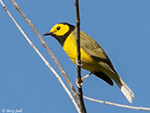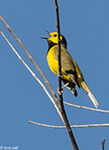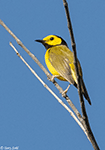| Length: 5.25 inches | Wingspan: 8 inches | Seasonality: Migrant |
|
ID Keys: (Male): Black hood around yellow face, bright yellow underparts,
olive-green upperparts. (Female): Olive-green upperparts, yellow face and underparts, crown usually olive-green but sometimes black with extending thin black "necklace" (a "shadow" of the hood). |
||
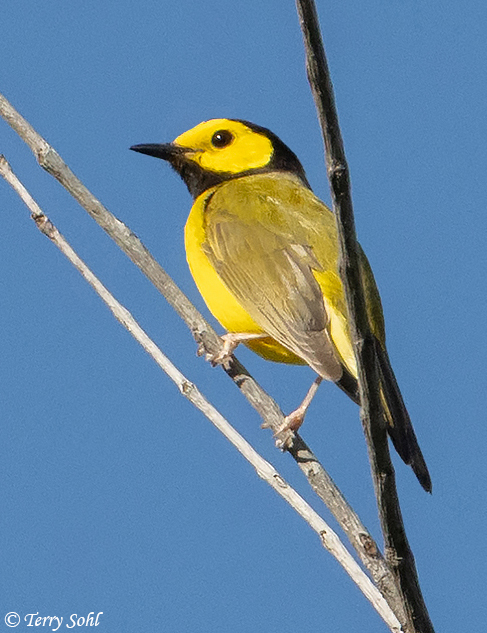 Hooded Warblers are normally
found deep in the forest undergrowth of the eastern United States, although they
will often call attention to themselves by fanning their tails and exposing the
white outer tail feather spots. While both sexes are most often found low
in the undergrowth, males will sometimes perch in higher exposed spots to sing
during the summer breeding season.
Hooded Warblers are normally
found deep in the forest undergrowth of the eastern United States, although they
will often call attention to themselves by fanning their tails and exposing the
white outer tail feather spots. While both sexes are most often found low
in the undergrowth, males will sometimes perch in higher exposed spots to sing
during the summer breeding season.
Hooded Warblers are consider rare to accidental migrants in South Dakota, as their normal range is several hundred miles to the southeast. The few sightings that have occurred have primarily been in the far southeastern part of the state, although there are a handful of sightings elsewhere. The vast majority of sightings have been during the month of May, in migration. While presumed to rarely if ever nest in South Dakota, the bird on the right was found singing in Newton Hills State Park in May of 2020, and was still present at least into July, signifying some attempt to find a mate and breed. In 1998, "Alkali Horse Camp" on the edge of the Black Hills was an extremely far out-of-range sighting, with observers recording seeing the birds feeding young.
Habitat:
During the summer breeding season, they are found in the undergrowth of deciduous and mixed forests, usually towards the interior of the forest. Also found in deciduous and mixed forests during the winter, as well as second-growth forests and other disturbed areas.
Diet:
Primarily feeds on insects and spiders.
Behavior:
Usually forages low in the vegetation or on the ground, searching for insects on foliage and branches. They will also occasionally take flying insects from midair.
Breeding Map:
(Presumed) non-breeder in South Dakota. In their breeding range, the nest is placed in a shrub or thicket, often near a forest clearing, typically 1 to 5 feet from the ground. The nest itself is built with leaves on the outside, lined with grasses, roots, and down. The female lays 3 to 5 eggs, with both parents helping to incubate them. The young hatch after about 12 days, and fledge from the nest 9 or 10 days after hatching.
Song:
Strong clear notes, emphasized at the end...tawee tawee taweeTEEoh. They also have a sharp chip call.
1Click here to hear the song of a Hooded Warbler
2Click here to hear another song of Hooded Warblers, with two males counter-singing
3Click here to hear the call of a Hooded Warbler
Migration:
Summers throughout much of the eastern United States south of the Great Lakes and New England. Winters in southern Mexico and Central America.
Interactive eBird Map:
Click to access an interactive eBird map of Hooded Warbler sightings
Similar Species:
As one of several yellow-and-black warbler species that can potentially be found in South Dakota at certain times, Hooded Warblers could potentially be confused with the following species if that color pattern isn't seen well:
- Wilson's Warbler - Males of both species are yellow underneath, a slightly olivish-yellow above, and have a black cap. However, on a male Wilson's Warbler, the black is restricted to that cap, while male Hooded Warblers have a mostly black head, throat, and nape, with a yellow mask. Females of the two species are much more difficult to tell apart, but female Hooded Warblers tend to have more contrast in tone on the face (somewhat mimicking the male pattern, but without the strong black and white color contrast). Female Hooded Warblers also have white on the tail feathers that's evident in flight.
- Kentucky Warbler - Males of both species share the yellow overall body and a black and yellow pattern on the head. However, on a male Kentucky Warbler, the black consists of a black cap, eyeline, and cheek, with a yellow stripe above the eye and a yellow throat. On a male Hooded Warbler the head and throat are both largely black, with a yellow mask. Female Kentucky Warblers have a more strongly marked face than a female Hooded Warbler, one that mimics the color pattern of a Male Kentucky Warbler but more faintly.
- Yellow Warbler - One of the most common warbler species in South Dakota, and one that sticks around in summer to breed, males aren't likely to be confused as male Yellow Warblers have no black in the plumage. Females are quite similar though, with a yellow tone overall. Female Yellow Warblers are, well...more uniformly yellow than a female Hood Warbler, with less contrast between the back and undersides.
Conservation Status:
Hooded Warblers have historically been very frequent hosts to Brown-headed Cowbird parasitism, and have likely become even more frequent victims over the last century as habitats become more fragmented and they are subject to more Cowbird exposure. However, overall populations appear to be stable or even undergoing slight increases in recent decades. They are found over a relatively broad geographic area, and are common in parts of that range. The IUCN thus lists the Hooded Warbler as a species of "Least Concern".
Further Information:
3) Audubon Guide - Hooded Warbler
Photo Information: June 11th, 2020 - Newton Hills State Park, South Dakota - Terry Sohl
Audio File Credits:
1Jacob Saucier. Recorded in Stafford County, Virginia on May 14th, 2017. Original recording and information from xeno-canto.
2John Middleton. Recorded in Layfaette County, Florida on April 4th, 2019. Original recording and information from xeno-canto.
3Matt Wistrand. Recorded in Carter County, Tennessee on August 2nd, 2016. Original recording and information from xeno-canto.
| Click on the map below for a higher-resolution view |
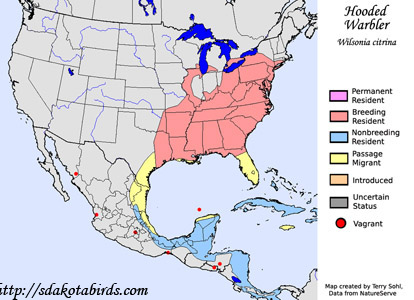 |
| South Dakota Status: Casual Spring migrant, accidental Fall migrant in the eastern part of the states. Accidental in the western part. |
Additional Hooded Warbler Photos
